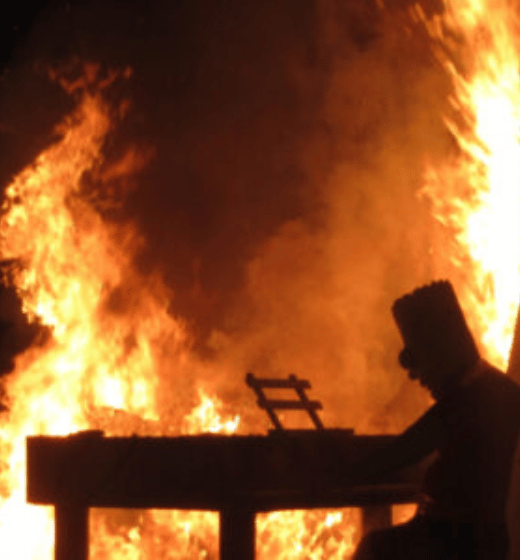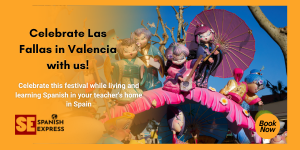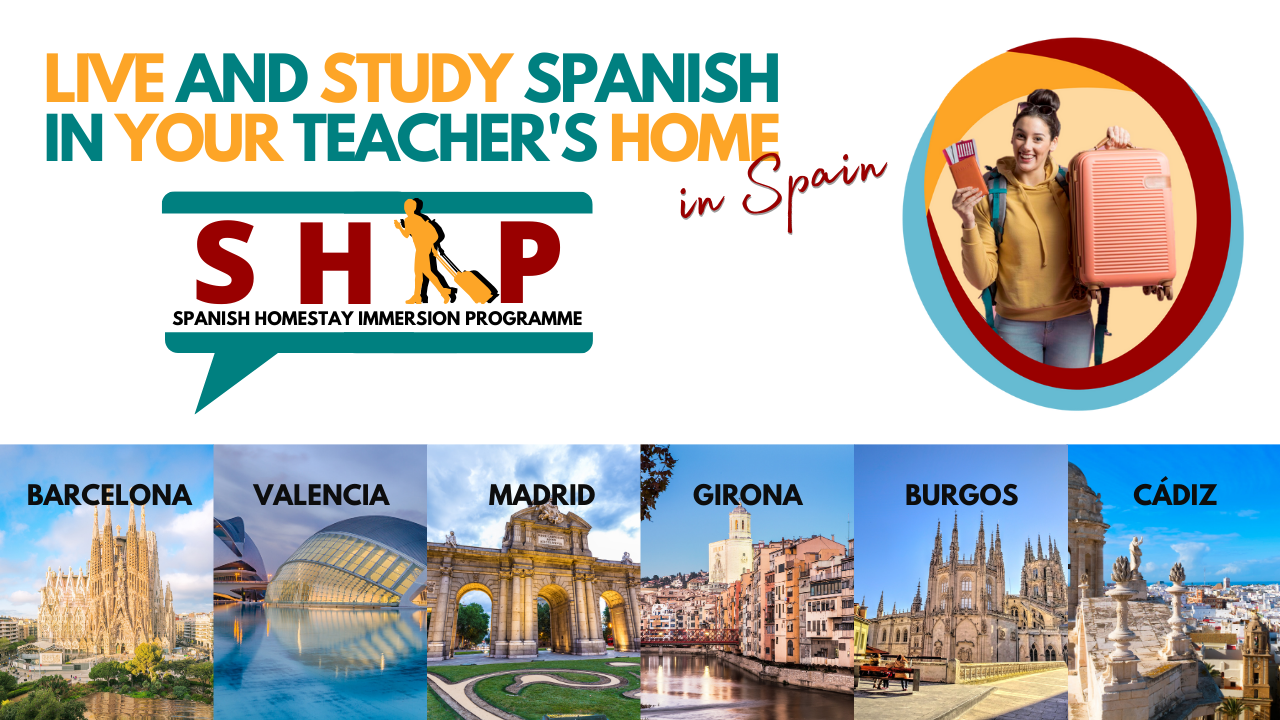

Classes and practice are very important for learning Spanish. However, studying certain aspects of Hispanic culture is also an essential part of learning. ✏️
Spanish Express knows this very well. Therefore, apart from providing you with regular teaching tools, we also provide you with interesting facts about Spanish culture. 😄
Today we are going to tell you about Las Fallas de Valencia, one of the most famous festivities in the whole peninsula. 🎆
Have you ever heard of the fallas celebrations? Do you know why the statues are burnt? 🤔
Let’s learn about this festivity together! 📚
Let’s get started!
Las Fallas de Valencia
The Las Fallas festival’s origins are unclear, but it likely started with Valencia’s carpenters burning old materials on the eve of Saint Joseph’s Day (19 March), their patron saint. This act of burning, symbolizing renewal, has evolved into a significant celebration.
The term “falla” originally referred to the communal fires that brought light and warmth. Now, these fires mark a tradition of letting go of the past, symbolized by huge bonfires in places like the town hall square, to welcome new beginnings.
The event, recognized as an intangible cultural heritage, transforms the city with lively music, elaborate firework displays, and street parties, culminating in the spectacular burning of the main falla. This festival vividly showcases the community’s spirit of rebirth and celebration.
Why are monuments burnt in the Fallas in Valencia?
In Valencia, people started burning dolls, called “ninots”, during a carpenters’ event. These ninots looked like real people disliked by many.
On the night before Saint Joseph’s Day, March 19, locals would display and burn a funny monument in the streets, like in the city centre or near the Plaza de la Virgen.
Each funny monument, named after famous areas in Valencia, joined a competition for prizes. These big figures, made of cardboard, wood, and paint, could be as tall as 20 meters. They made fun of local news or politics but always in a humorous way.
This tradition is part of the Las Fallas festival, known for its fire parades, fireworks, and lots of laughter. It’s a time when the city, from the city hall square to turia gardens, celebrates with a big party, welcoming spring with open arms.
The Fallas festival begins on March 15th!
Like most folk celebrations, music and local involvement are key in Las Fallas de Valencia, attracting tourists worldwide. Locals, called “falleros,” wear traditional attire, with local bands providing lively tunes.
Events like the fire parade, la nit del foc, and the flower offering highlight Valencia’s vibrant culture. The ninot exhibition and the grand finale, la cremà, are standout moments.
The plaça de l’ajuntament buzzes with activity, especially during la mascletà, showcasing dazzling fireworks. As fallas season peaks, Valencia transforms with festivities in every neighborhood, celebrating Saint Joseph’s Day on 19th March and welcoming spring.
The Heartbeat of Valencia
The Offering of Flowers to the Virgen de los Desamparados occurs on the 17th and 18th of March, a significant event in the Fallas de Valencia. Mascletàs light up Plaza del Ayuntamiento daily, with grand firework displays illuminating the sky on the night of the 18th of March.
The celebration concludes with the Cremà on the 19th of March, marking the end of the festive week. This moment, filled with emotion, often sees the Falleras Mayores moved to tears by the sight of the burning effigies.
The cycle then begins anew, as fallero artisans soon start crafting their next creations, looking forward to the next celebration. This cycle of renewal, celebrated across Valencia, from ciutat fallera to l’antiga de campanar, underscores the community’s resilience and joy.
Happy Saint Joseph’s Day to everyone, as we celebrate the patron saint of carpenters and the arrival of spring, ready to embrace all the fallas and their vibrant festivities once again.
From Fire to Flowers: The Rich Traditions of Valencia’s Las Fallas
Due to its popularity and the fervor it arouses year after year, this festival has been declared a Festival of International Tourist Interest. On the other hand, UNESCO recognizes it as an Intangible Heritage of Humanity.
Las Fallas de Valencia is an important part of Spanish culture. Music, color, and popular excitement are the main protagonists throughout the day.
Undoubtedly, it is a very special tradition that is worth experiencing first-hand, with events like the falla infantil, and the cavalcada del foc.
The breathtaking fireworks displays are all set against the backdrop of Valencia’s vibrant streets and the revered Lady of the Forsaken.
Travel to Valencia and feel the warmth of the Fallas!
We wouldn’t be surprised if after reading this article you feel like traveling and experiencing Las Fallas de Valencia in the front row. ✈️
If that’s the case, we have excellent news for you: you can make your dream come true by participating in our Spanish Homestay Immersion Programme (SHIP)! 🏠
For 20 years Spanish Express has been offering this immersion program whose main focus is to walk learning and fun in one place. This way, we guarantee the best way to learn Spanish. 🇪🇸
Valencia is one of our SHIP destinations. If you want to learn Spanish in this beautiful city and experience the Fallas like a Valencian, just contact us and ask for information. 🏠
Hispanic culture is vital for learning the language. Traditions, art, music, and literature are a fundamental part of the study of Spanish. 😀
Other destinations in our SHIP include Mallorca, Barcelona and Cadiz. Have a look at them and decide on your next venture. 😎
Live and learn Spanish in the home of one of our teachers! ✏️
We are waiting for you!
What can you see at Plaza del Ayuntamiento?
At Plaza del Ayuntamiento, you can see amazing fireworks displays and the event called la despertà. The place is full of life, especially during the Las Fallas festival. You’ll also find beautiful buildings around and people bringing flowers for the celebrations.
What’s special about Plaza de la Virgen?
Plaza de la Virgen is special because it’s a central spot in Valencia for gatherings and traditions. During Las Fallas, it hosts events like the offering of flowers to Saint Joseph and showcases the children’s falla. It’s a place where history meets vibrant local culture.
What are 4 events that happened during the Fallas celebration?
During the Fallas celebration, four key events are: the firework displays that light up the night sky, the early morning wake-up call known as la despertà, the emotional flower offering where people bring flowers, and the burning of the Fallas sculptures, a dramatic finale where all the pieces are set on fire in a spectacular display.
How many Fallas are there in Valencia 2023?
In Valencia 2023, there were hundreds of Fallas spread across different neighborhoods. Each area, from the city centre to the outskirts, showcased its own unique Falla, making the city a mosaic of creativity and celebration.













